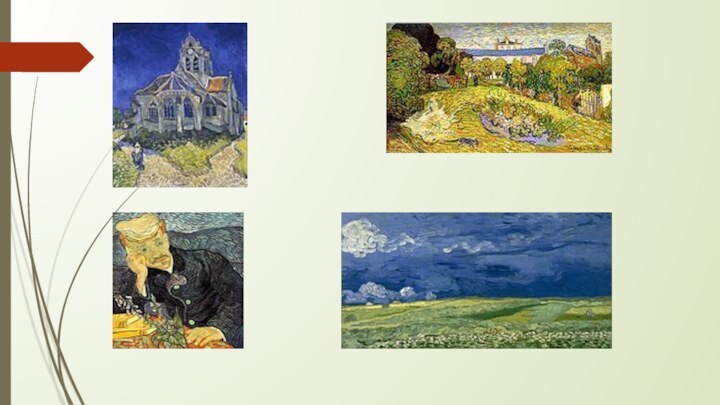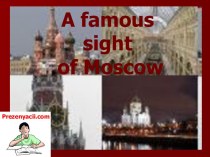- Главная
- Разное
- Бизнес и предпринимательство
- Образование
- Развлечения
- Государство
- Спорт
- Графика
- Культурология
- Еда и кулинария
- Лингвистика
- Религиоведение
- Черчение
- Физкультура
- ИЗО
- Психология
- Социология
- Английский язык
- Астрономия
- Алгебра
- Биология
- География
- Геометрия
- Детские презентации
- Информатика
- История
- Литература
- Маркетинг
- Математика
- Медицина
- Менеджмент
- Музыка
- МХК
- Немецкий язык
- ОБЖ
- Обществознание
- Окружающий мир
- Педагогика
- Русский язык
- Технология
- Физика
- Философия
- Химия
- Шаблоны, картинки для презентаций
- Экология
- Экономика
- Юриспруденция
Что такое findslide.org?
FindSlide.org - это сайт презентаций, докладов, шаблонов в формате PowerPoint.
Обратная связь
Email: Нажмите что бы посмотреть
Презентация на тему Vincent van Gogh
Содержание
Vincent Willem van Gogh ( 30 March 1853 – 29 July 1890) was a major Post-Impressionist. A Dutch painter whose work—notable for its rough beauty, emotional honesty, and bold color—had a far-reaching influence on 20th-century art.










Слайд 3 He spent his early adulthood working for a
firm of art dealers, traveling between The Hague, London,
and Paris, after which he taught for a time in England at Isleworth and Ramsgate. One of his early aspirations was to become a pastor, and from 1879 he worked as a missionary in a mining region in Belgium, where he began to sketch people from the local community. In 1885, he painted his first major work, entitled The Potato Eaters. His palette at the time consisted mainly of somber earth tones and showed no sign of the vivid coloration that distinguished his later work. In March 1886, he moved to Paris and discovered the French Impressionists. Later, he moved to the south of France and was influenced by the strong sunlight he found there. His work grew brighter in color, and he developed the unique and highly recognizable style that became fully realized during his stay in Arles in 1888. The extent to which his mental health affected his painting has been a subject of speculation since his death. Despite a widespread tendency to romanticize his ill health, modern critics see an artist deeply frustrated by the inactivity and incoherence brought about by his bouts of illness. According to art critic Robert Hughes, Van Gogh's late works show an artist at the height of his ability, completely in control and "longing for concision and grace".
Слайд 4
Paris (1886–1888)
Van Gogh traveled to Paris in March
1886, where he shared Theo's Rue Laval apartment onMontmartre,
to study at Fernand Cormon's studio. In June, they took a larger apartment further uphill, at 54 Rue Lepic. Because they had no need to write letters to communicate, little is known about this stay in Paris. In Paris, he painted portrait friends and acquaintances, still-life paintings, views ofLe Moulin de la Galette, scenes in Montmartre, Asnières, and along the Seine. During his stay in Paris, he collected more Japanese ukiyo-e woodblock prints; he became interested in such workswhen, in 1885, in Antwerp he used them to decorate the walls of his studio. He collected hundreds of prints, which are visible in the backgrounds of several of his paintings. In his 1887 Portrait of Père Tanguy, several can be seen hanging on the wall behind the main figure. In the Courtesan or Oiran (after Kesai Eisen) (1887), Van Gogh traced the figure from a reproduction on the cover of the magazine Paris Illustre, which he then graphically enlarged in the painting. His 1888 Plum Tree in Blossom (After Hiroshige) is a vivid example of the admiration he had for the prints he collected. His version is slightly bolder than Hiroshige's original.Слайд 6 In May 1890, Van Gogh left the clinic
in Saint-Rémy to move nearer the physician Dr. Paul
Gachet in Auvers-sur-Oise, and also to Theo. Gachet was recommended by Camille Pissarro, had treated several other artists, and was himself an amateur artist. Van Gogh's first impression was that Gachet was "...sicker than I am, I think, or shall we say just as much." In June 1890, he painted several portraits of the physician, including Portrait of Dr. Gachet, and his only etching; in each, the emphasis is on Gachet's melancholic disposition. Van Gogh stayed at the Auberge Ravoux, where he paid 3 francs and 50 centimes to rent an attic room measuring 75 square feetA picture of a vast open landscape field, dark blue sky over yellowish and green land.
Wheatfield Under Thunderclouds, July 1890, Van Gogh Museum, Amsterdam, , painted in July 1890 during his last weeks.[146]
A frontal view of a church, with darkened blue sky overhead, we see the back of a small single figure of a woman walking away from us on the road in front of the building to the left into the distance.
The Church at Auvers, 1890, Musée d'Orsay, Paris
A redheaded man wearing a cap, a black jacket with green buttons; with a red mustache and scraggly Van Dyke beard is leaning on his arm to the left looking slightly to the right. He is seated at a table with two yellow books and a red tablecloth. In the foreground on the table is a clear glass vase with flowers. In the background are hills and a dark blue starless night sky.
Portrait of Dr. Gachet, 1890, was sold for US$ 82.5 million in 1990. Private collection
Before he left, in his last weeks at Saint-Rémy, Van Gogh's thoughts returned to his "memories of the North", and several of the approximately 70 oils he painted during his 70 days in Auvers-sur-Oise, such as The Church at Auvers, are reminiscent of northern scenes.
Wheat Field with Crows (July 1890) is an example of the use of double square canvases he developed in the last weeks of his life in which he paired two square blank canvases to form a single, larger canvas. In its turbulent intensity, it is among his most haunting and elemental works. It is often mistakenly believed to be his last work, but Hulsker lists seven paintings that postdate it
Barbizon painter Charles Daubigny had moved to Auvers in 1861, and this in turn drew other artists there, including Camille Corot and Honoré Daumier. In July 1890, Van Gogh completed two paintings of Daubigny's Garden; one of these is likely to be his final work. There are also paintings that show evidence of being unfinished, including Thatched Cottages by a Hill.
Слайд 8
Flowers
Van Gogh painted several versions of landscapes with
flowers, including hisView of Arles with Irises, and paintings
of flowers, including Irises, Sunflowers, lilacs and roses. Some reflect his interests in the language of color, and also in Japanese ukiyo-e woodblock printsA field with flowers, various plants and trees in front of a several buildings (some of which are either tall or on a hill).
View of Arles with Irises, 1888, Van Gogh Museum, Amsterdam.
A field of flowers. The foreground includes long green stems with blue flowers, while the background includes prominent gold flowers on the left; white flowers in the center and a field to the right.
Irises, 1889, Getty Center, Los Angeles
He completed two series of sunflowers. The first dated from his 1887 stay in Paris, the second during his visit to Arles the following year. The Paris series shows living flowers in the ground, in the second, they are dying in vases. The 1888 paintings were created during a rare period of optimism for the artist. He intended them to decorate a bedroom where Gauguin was supposed to stay in Arles that August, when the two would create the community of artists Van Gogh had long hoped for. The flowers are rendered with thick brushstrokes (impasto) and heavy layers of paint.
In an August 1888 letter to Theo, he wrote,
"I am hard at it, painting with the enthusiasm of a Marseillais eating bouillabaisse, which won't surprise you when you know that what I'm at is the painting of some sunflowers. If I carry out this idea there will be a dozen panels. So the whole thing will be a symphony in blue and yellow. I am working at it every morning from sunrise on, for the flowers fade so quickly. I am now on the fourth picture of sunflowers. This fourth one is a bunch of 14 flowers ... it gives a singular effect."





























